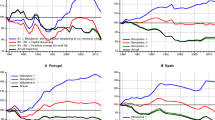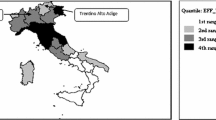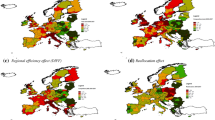Abstract
Improving production efficiency at the regional level is often considered a means to reduce regional inequality. This article studies regional efficiency convergence across provinces in Indonesia over the 1990–2010 period. Through the lens of both classical and distributional convergence frameworks, the dispersion dynamics of the following three indicators are contrasted: overall efficiency, pure efficiency, and scale efficiency. Results from the classical convergence approach suggest that—on average—there is regional convergence in all these three efficiency measures. However, results from the distributional convergence approach indicate the existence of two local convergence clusters within the overall and pure efficiency distributions. Moreover, since scale efficiency is characterized by only one convergence cluster, the two clusters of pure efficiency appear to be driving the overall regional efficiency dynamics in Indonesia. The article concludes highlighting the importance of monitoring and evaluating heterogeneous (beyond average) behaviour, multiple convergence clusters, and geographic proximity when formulating regional policies that aim to reduce regional inequality.
Similar content being viewed by others
Notes
To reduce economic jargon, in the rest of this article, the term pure efficiency (PE) will be used to refer to the concept of pure efficiency that is used the DEA framework.
In this article, the terms provinces or regions are used interchangeably. However, sometimes the former is used to emphasize an empirical construct and the latter is used to emphasize a more conceptual unit of analysis.
Although the work of Mokoginta and Wijaya (2016) and Kataoka (2018) indicate conflicting results, their efficiency measures are not directly comparable. One potential factor behind these conflicting results, in addition to differences in time horizon and number of provinces, is that Mokoginta and Wijaya (2016) include government consumption as an input for the computation of efficiency scores.
Political reforms in the late 1990s increased the number of provinces from 27 to 34. Thus, to avoid comparability problems, only 26 provinces are considered in the analysis. See footnote 5 of Kataoka (2018) for details about the aggregation of new and existing provinces.
For the purposes of the present article, the terms“decision-making units” and “production units” are used interchangeably.
Human capital is proxied by the average period of education, weighted by the educational attainment of the provincial labour force. Physical capital estimates are from Kataoka (2013) and they are based on the perpetual inventory method.
Optimal flexible bandwidths are derived from the the minimization of the asymptotic mean integrated square error (AMISE).
Figures 2, 3 and 4 graphically illustrate the stochastic kernel (Eq. 7) from different yet complementary perspectives. Panels A and C are based on the numerator of Eq. 7 while Panels B and D are based on the entire ratio. Note that the commonality among all panels is that they all represent a bi-variate distribution. However, only Panels B and D represent a bi-variate conditional distribution (that is, Eq. 7).
As in Menardi and Azzalini (2014), the word “core” cluster refers to a group of observations that are identified based on the higher level sets of a density function.
References
Akita T (1988) Regional development and income disparities in Indonesia. Asian Econ J 2(2):165–191
Arbia G, Basile R, Piras G (2006) Analyzing Intra-Distribution Dynamics: A Reappraisal. ERSA conference papers ERSA06p262, European Regional Science Association. https://ideas.repec.org/p/wiw/wiwrsa/ersa06p262.html. Accessed 22 Jan 2019
Azzalini A, Torelli N (2007) Clustering via nonparametric density estimation. Stat Comput 17(1):71–80
Banker RD, Charnes A, Cooper WW (1984) Some models for estimating technical and scale inefficiencies in data envelopment analysis. Manag Sci 30(9):1078–1092
Barro R, Sala-I-Martin X (1991) Convergence across states and regions. Brook Papers Econ Activity 1991:107–182
Barro R, Sala-I-Martin X (1992a) Convergence. J Polit Econ 100(2):223–251
Barro R, Sala-I-Martin X (1992b) Regional growth and migration: a Japan-United States comparison. J Jpn Int Econ 6(4):312–346
Bendesa IKG, Meydianawathi LG, Handra H, Djoni Hartono DP, Resosudarmo BP, Yusuf AA (2016) Tourism and sustainable regional development. Padjadjaran University Press, Bandung
Bianco SD (2016) Going clubbing in the eighties: convergence in manufacturing sectors at a glance. Empir Econ 50(2):623–659. https://doi.org/10.1007/s00181-015-0940-0
Caselli F (2005) Accounting for cross-country income differences. Handb Econ Growth 1:679–741
Charnes A, Cooper WW, Rhodes E (1978) Measuring the efficiency of decision making units. Eur J Oper Res 2(6):429–444
Charnes A, Cooper WW, Li S (1989) Using data envelopment analysis to evaluate efficiency in the economic performance of chinese cities. Socio-Econ Plan Sci 23(6):325–344
Cole MA, Neumayer E (2003) The pitfalls of convergence analysis: is the income gap really widening? Appl Econ Lett 10(6):355–357
Dalgaard CJ, Vastrup J (2001) On the measurement of \(\sigma\)-convergence. Econ Lett 70(2):283–287
Epstein P, Howlett P, Schulze MS (2003) Distribution dynamics: stratification, polarization, and convergence among oecd economies, 1870–1992. Explor Econ Hist 40(1):78–97
Esmara H (1975) Regional income disparities. Bull Indones Econ Stud 11(1):41–57
Garcia JG, Soelistianingsih L (1998) Why do differences in provincial incomes persist in Indonesia? Bull Indones Econ Stud 34(1):95–120
Gunawan A, Mendez C, Santos-Marquez F (2019) Regional income disparities, distributional convergence, and spatial effects: evidence from Indonesia. MPRA Working Paper 95972, University Library of Munich, Germany. https://ideas.repec.org/p/pra/mprapa/97090.html. Accessed 10 Oct 2019
Halkos GE, Tzeremes NG (2010) Measuring regional economic efficiency: the case of greek prefectures. Ann Reg Sci 45(3):603–632
Hyndman R, Bashtannyk D, Grunwald G (1996) Estimating and visualizing conditional densities. J Comput Graph Stat 5(4):315–336
Johnson PA (2005) A continuous state space approach to convergence by parts. Econ Lett 86(3):317–321
Kataoka M (2012) Economic growth and interregional resource allocation in indonesia. Stud Reg Sci 42(4):911–920
Kataoka M (2013) Capital stock estimates by province and interprovincial distribution in Indonesia. Asian Econ J 27(4):409–428
Kataoka M (2018) Inequality convergence in inefficiency and interprovincial income inequality in Indonesia for 1990–2010. Asia-Pac J Reg Sci 2(2):297–313
Kharisma B, Saleh S (2013) Convergence of income among provinces in Indonesia, 1984–2008: A panel data approach. J Indones Econ Bus 28(2):167–187
Kurniawan H, de Groot HL, Mulder P (2019) Are poor provinces catching-up the rich provinces in Indonesia? Reg Sci Policy Pract 11(1):89–108
Magrini S (1999) The evolution of income disparities among the regions of the european union. Reg Sci Urban Econ 29(2):257–281
Magrini S (2004) Regional (di) convergence. In: Henderson VJ, Thisse J (Eds) Handbook of regional and urban economics, vol 4. Elsevier, pp 2741–2796
Magrini S (2009) Why should we analyse convergence using the distribution dynamics approach? Sci Reg 8(1):5–34
Menardi G, Azzalini A (2014) An advancement in clustering via nonparametric density estimation. Stat Comput 24(5):753–767
Mendez C (2018) On the distribution dynamics of human development: Evidence from the metropolitan regions of Bolivia. Econ Bull 38(4):2467–2475. https://ideas.repec.org/a/ebl/ecbull/eb-18-00452.html. Accessed 10 Oct 2019
Mokoginta I, Wijaya M (2015) Measuring economic efficiency of provinces in Indonesia. Parahyangan Catholic University Working Paper
Mokoginta I, Wijaya M (2016) Measuring economic efficiency of provinces in Indonesia. In: Bendesa IKG, Meydianawathi LG, Handra H, Djoni Hartono DP, Resosudarmo B, Yusuf A (Eds) Tourism and sustainable regional development. Padjadjaran University Press, Bandung, pp 3–26
Pittau MG, Zelli R, Massari R (2016) Evidence of convergence clubs using mixture models. Econ Rev 35(7):1317–1342
Quah D (1993) Galton’s fallacy and tests of the convergence hypothesis. Scand J Econ 95(4):427–443
Quah D (1996) Twin peaks: growth and convergence in models of distribution dynamics. Econ J 106(437):1045–1055
Quah D (1997) Empirics for growth and distribution: stratification, polarization, and convergence clubs. J Econ Growth 2(1):27–59
Ram R (2018) Comparison of cross-country measures of sigma-convergence in per-capita income, 1960–2010. Appl Econ Lett 25(14):1010–1014
Resosudarmo BP, Vidyattama Y (2006) Regional income disparity in Indonesia: A panel data analysis. ASEAN Economic Bulletin 23(1):31–44
Sakamoto H (2007) The dynamics of inter-provincial income distribution in Indonesia. The International Centre for the Study of East Asian Development Working Paper 2007-25
Sala-I-Martin XX (1996) Regional cohesion: evidence and theories of regional growth and convergence. Eur Econ Rev 40(6):1325–1352
Schaffer A, Simar L, Rauland J (2011) Decomposing regional efficiency. J Reg Sci 51(5):931–947
Stolp C (1990) Strengths and weaknesses of data envelopment analysis: an urban and regional perspective. Comput Environ Urban Syst 14(2):103–116
Tirtosuharto D (2010) The impact of fiscal decentralization and state allocative efficiency on regional growth in indonesia. J Int Commerce Econ Policy 1(02):287–307
Young AT, Higgins MJ, Levy D (2008) Sigma convergence versus beta convergence: evidence from US county-level data. J Money Credit Bank 40(5):1083–1093
Author information
Authors and Affiliations
Corresponding author
Additional information
Publisher's Note
Springer Nature remains neutral with regard to jurisdictional claims in published maps and institutional affiliations.
Appendix
Appendix
About this article
Cite this article
Mendez, C. Regional efficiency convergence and efficiency clusters. Asia-Pac J Reg Sci 4, 391–411 (2020). https://doi.org/10.1007/s41685-020-00144-w
Received:
Accepted:
Published:
Issue Date:
DOI: https://doi.org/10.1007/s41685-020-00144-w












